Ancient Byblos: Powerful Phoenician City With Own Kings
A. Sutherland - AncientPages.com - According to the Amarna Letters and the annals of Thutmose III, Byblos ('Papyrus' in Greek) was dependent and subservient to Egypt for hundreds of years.
Carved limestone sarcophagus of Ahiram, a king of Byblos, bearing a Phoenician inscription, 10th century BC; Credits: National Museum of Lebanon, Beirut via Britannica
However, these ancient texts do not indicate that this Phoenician city remained wealthy during this period.
Most of the ancient Phoenician cities were located along the coastline of today's modern countries of Israel and Lebanon.
The primary Phoenician cities were Byblos, located the farthest to the north along this coastline, Tyre at the south end, and Sidon between the two.
Early in Phoenician history, Byblos was the most important of the three cities. The oldest known historical mention of the town is on the ancient Egyptian "Palermo Stone," dated to the reign of the Fourth Dynasty Egyptian king Snefru.
 St. John-Mark Church, Byblos. source
St. John-Mark Church, Byblos. source
Founded as Gebal by the Phoenicians, Byblos is believed to have been continuously occupied between 8800 and 7000 BC. It's among the oldest cities in the world, located about 35 kilometers (23 miles) north of the capital Beirut in modern-day Lebanon.
The modern port city of Byblos is built upon multiple layers of ancient ruins.
It was given its name by the Greeks, who imported papyrus from the city, which has a history of diverse cultures closely related to the Mediterranean for millennia.
It began as a small fishing village called Gubal (or Gebal), while the coastal region of the land, which the Greeks named Phoenicia, was known to the inhabitants as Canaan.
By 3000 BC, Byblos became a prosperous city through trade and the most crucial timber shipping port to Egypt and elsewhere.
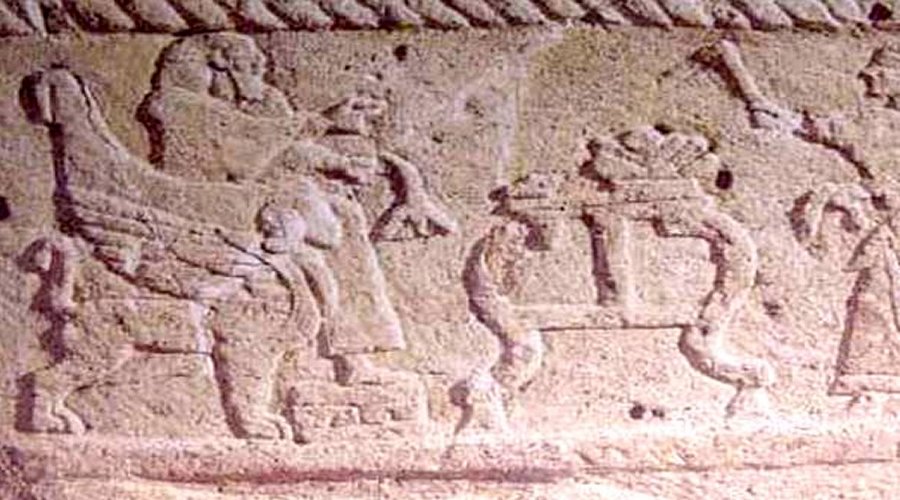 Bas relief is from his sarcophagus. The Cherubim have been identified as Winged Sphinxes (p. 127. Sabatino Moscati. The Phoenicians. Gruppo Editoriale Fabbri Bompiani, Sonzono, Etas S.p.A. Milan. March 1988
Bas relief is from his sarcophagus. The Cherubim have been identified as Winged Sphinxes (p. 127. Sabatino Moscati. The Phoenicians. Gruppo Editoriale Fabbri Bompiani, Sonzono, Etas S.p.A. Milan. March 1988
Byblos was also the first city to perfect shipbuilding, and it is primarily due to the craftsmanship of the shipwrights of the town that Phoenicians acquired their fame as sailors and "princes of the sea" (as they are referred to in the biblical book of Ezekiel).
It was also when the most significant powers of the ancient New East, such as the Hittites, Babylon, and Egypt, dominated the region. They divided smaller kingdoms amongst themselves. Byblos and most of Phoenicia fell under Egyptian control.
Archaeological evidence shows that ancient Byblos was a walled city with both a land and a sea gateway during Egyptian domination. Byblos' planning was relatively advanced for the time.
Byblos streets were built concentrically to the town center, and canals carried rain and drainage water away. Many funerary offerings indicate that the inhabitants of Byblos prospered financially and materially despite their subordination to Egypt.
Historians believe that it was possible mainly due to trade with the Egyptians. Egypt delivered gold, papyrus, alabaster, and linen to Phoenicia. The Phoenicians had cedar and other wood for shipbuilding, tomb construction, and funerary ritual, which the Old Kingdom's pharaohs needed.
 The Obelisk temple is named after the nearly 30 obelisks discovered standing in the temple’s courtyard.
The Obelisk temple is named after the nearly 30 obelisks discovered standing in the temple’s courtyard.
The Phoenicians then developed their alphabet of 22 characters, which replaced cuneiform in written communication. Through trade routes, the Phoenician alphabet traveled first to Greece around 800 BC and then spread to other countries through Greek merchants.
Between 1100 and 725 BC, Byblos declined in importance, but later it began to prosper again.
This city has a turbulent history of at least 6,000 years, full of interactions with various cultures, which left the Bronze Age's monumental temples, the Persian fortifications, the Roman road, Byzantine churches, the Crusade citadel, and the Medieval and Ottoman town.
Under Arab rule beginning in 637 AD, Byblos started to decline in wealth and importance. The great port was virtually ignored for centuries; thus, the city became an easy target for invading Crusaders in 1098 AD. Once the Crusaders left, the Muslim rulers neglected the town until it was utterly forgotten for centuries.
In 1860 AD, thanks to the French historian Ernest Renan, the ancient site was rediscovered, and continuous excavations took place between 1925 and 1975.
This city has a turbulent history of at least 6,000 years, full of interactions with various cultures, which left the Bronze Age's monumental temples, the Persian fortifications, the Roman road, Byzantine churches, the Crusade citadel, and the Medieval and Ottoman town.
Under Arab rule beginning in 637 AD, Byblos started to decline in wealth and importance. The great port was virtually ignored for centuries; thus, the city became an easy target for invading Crusaders in 1098 AD. Once the Crusaders were driven out, the Muslim rulers neglected the town until it was forgotten for centuries.
In 1860 AD, thanks to the French historian Ernest Renan, the ancient site was rediscovered, and continuous excavations were organized from 1925 to 1975.
Written by – A. Sutherland AncientPages.com Staff Writer
Updated on December 30, 2023
Copyright © AncientPages.com All rights reserved. This material may not be published, broadcast, rewritten or redistributed in whole or part without the express written permission of AncientPages.com
Expand for referencesReferences:
M. De Lafayette, Phoenicia, Ur, and Carthage: Artifacts, Inscriptions, Slabs, Sites
Bob E.J.H. Becking, L. Grabbe, Between Evidence and Ideology
More From Ancient Pages
-
 New Underwater Discoveries Made Around The Antikythera Shipwreck
Archaeology | Jul 21, 2023
New Underwater Discoveries Made Around The Antikythera Shipwreck
Archaeology | Jul 21, 2023 -
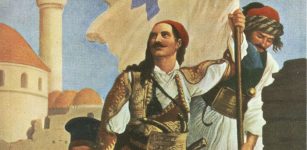 Horrible Ancient Massacre On The Island Of Chios Led To Greek Independence
Featured Stories | Jun 29, 2018
Horrible Ancient Massacre On The Island Of Chios Led To Greek Independence
Featured Stories | Jun 29, 2018 -
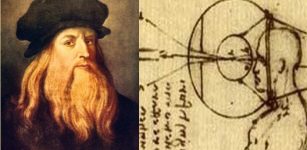 Did Leonardo Da Vinci Invent Contact Lenses In 1508?
Ancient Technology | Dec 10, 2015
Did Leonardo Da Vinci Invent Contact Lenses In 1508?
Ancient Technology | Dec 10, 2015 -
 Mysterious Magical Healing Gift Of The Whisperers – Meet The Enigmatic Szeptunka
Featured Stories | Feb 10, 2025
Mysterious Magical Healing Gift Of The Whisperers – Meet The Enigmatic Szeptunka
Featured Stories | Feb 10, 2025 -
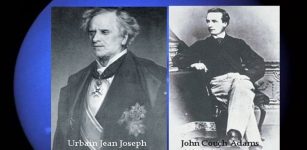 On This Day In History: Planet Neptune Officially Discovered – On Sep 23, 1846
News | Sep 23, 2016
On This Day In History: Planet Neptune Officially Discovered – On Sep 23, 1846
News | Sep 23, 2016 -
 Strange Engraving Made By Knights Templar In French Village – It Doesn’t Make Sense Or Does It? – Part 2
Ancient Mysteries | Oct 9, 2019
Strange Engraving Made By Knights Templar In French Village – It Doesn’t Make Sense Or Does It? – Part 2
Ancient Mysteries | Oct 9, 2019 -
 Jolabokaflod – Iceland’s Wonderful Christmas Book Flood Tradition – Exchange Books As Christmas Eve Presents And Spend The Evening Reading
Christmas Traditions | Dec 25, 2024
Jolabokaflod – Iceland’s Wonderful Christmas Book Flood Tradition – Exchange Books As Christmas Eve Presents And Spend The Evening Reading
Christmas Traditions | Dec 25, 2024 -
 Unique Find: Sacred Gate Found At The Minoan Palace Of Archanes In Crete
Archaeology | Nov 1, 2024
Unique Find: Sacred Gate Found At The Minoan Palace Of Archanes In Crete
Archaeology | Nov 1, 2024 -
 12,000-Year-Old Camel Rock Art In Arabia’s Desert Served As Ancient Signs To Water Sources
Archaeology | Oct 2, 2025
12,000-Year-Old Camel Rock Art In Arabia’s Desert Served As Ancient Signs To Water Sources
Archaeology | Oct 2, 2025 -
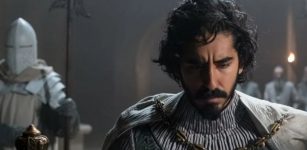 The Green Knight – New Movie Based On Arthurian Legend
Myths & Legends | Aug 7, 2021
The Green Knight – New Movie Based On Arthurian Legend
Myths & Legends | Aug 7, 2021 -
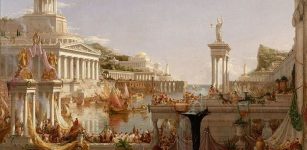 Mediterranean Sea Was Hotter 2,000 Years Ago And Contributed To The Fall Of The Roman Empire
Archaeology | Jul 27, 2020
Mediterranean Sea Was Hotter 2,000 Years Ago And Contributed To The Fall Of The Roman Empire
Archaeology | Jul 27, 2020 -
 Beads Show European Trade In African Interior Used Indigenous Routes
Archaeology | Sep 17, 2022
Beads Show European Trade In African Interior Used Indigenous Routes
Archaeology | Sep 17, 2022 -
 The Magnificent Yule Goat In Gävle, Sweden Has Finally Arrived
Christmas Traditions | Dec 2, 2024
The Magnificent Yule Goat In Gävle, Sweden Has Finally Arrived
Christmas Traditions | Dec 2, 2024 -
 First Solid Scientific Evidence That Vikings Brought Animals To Britain
Archaeology | Feb 1, 2023
First Solid Scientific Evidence That Vikings Brought Animals To Britain
Archaeology | Feb 1, 2023 -
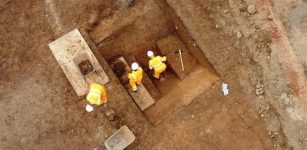 2,250-Year-Old Iron Age Settlement Discovered Near Upton-Upon-Severn
Archaeology | Jan 4, 2022
2,250-Year-Old Iron Age Settlement Discovered Near Upton-Upon-Severn
Archaeology | Jan 4, 2022 -
 Major Archaeological Discovery Of A 7,000-Year-Old Settlement In Miami – But Its Future Is In Danger
Archaeology | Feb 10, 2023
Major Archaeological Discovery Of A 7,000-Year-Old Settlement In Miami – But Its Future Is In Danger
Archaeology | Feb 10, 2023 -
 The Kitchen God In Ancient Vietnamese Tradition Is Still Alive
Featured Stories | Feb 23, 2016
The Kitchen God In Ancient Vietnamese Tradition Is Still Alive
Featured Stories | Feb 23, 2016 -
 On This Day In History: Great Siege of Malta: Ottoman Forces Made Attempt To Conquer Malta And Failed – On May 18, 1565
News | May 18, 2016
On This Day In History: Great Siege of Malta: Ottoman Forces Made Attempt To Conquer Malta And Failed – On May 18, 1565
News | May 18, 2016 -
 ‘Little Caesar’: Forgotten ‘King Of Kings’ Who Died Very Young
Featured Stories | May 11, 2020
‘Little Caesar’: Forgotten ‘King Of Kings’ Who Died Very Young
Featured Stories | May 11, 2020 -
 Mystery Of The Lost Biblical City Of Ai – Where Was It Located?
Ancient Mysteries | Apr 23, 2017
Mystery Of The Lost Biblical City Of Ai – Where Was It Located?
Ancient Mysteries | Apr 23, 2017

